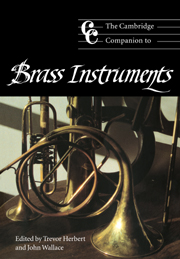Book contents
- Frontmatter
- Introduction
- 1 Lip-vibrated instruments of the ancient and non-western world
- 2 How brass instruments work
- 3 Design, technology and manufacture before 1800
- 4 Brass instruments in art music in the Middle Ages
- 5 The cornett
- 6 ‘Sackbut’: the early trombone
- 7 The trumpet before 1800
- 8 The horn in the Baroque and Classical periods
- 9 Design, technology and manufacture since 1800
- 10 Keyed brass
- 11 The low brass
- 12 Brass in the modern orchestra
- 13 Brass bands and other vernacular brass traditions
- 14 Playing, learning and teaching brass
- 15 The post-classical horn
- 16 Jazz, improvisation and brass
- 17 Brass solo and chamber music from 1800
- 18 Frontiers or byways? Brass instruments in avant-garde music
- Glossary
- Notes
- Select bibliography
- Index
9 - Design, technology and manufacture since 1800
Published online by Cambridge University Press: 28 September 2011
- Frontmatter
- Introduction
- 1 Lip-vibrated instruments of the ancient and non-western world
- 2 How brass instruments work
- 3 Design, technology and manufacture before 1800
- 4 Brass instruments in art music in the Middle Ages
- 5 The cornett
- 6 ‘Sackbut’: the early trombone
- 7 The trumpet before 1800
- 8 The horn in the Baroque and Classical periods
- 9 Design, technology and manufacture since 1800
- 10 Keyed brass
- 11 The low brass
- 12 Brass in the modern orchestra
- 13 Brass bands and other vernacular brass traditions
- 14 Playing, learning and teaching brass
- 15 The post-classical horn
- 16 Jazz, improvisation and brass
- 17 Brass solo and chamber music from 1800
- 18 Frontiers or byways? Brass instruments in avant-garde music
- Glossary
- Notes
- Select bibliography
- Index
Summary
In the nineteenth century, three processes took place simultaneously: the development of new types of brass instrument, further mechanisation in manufacture and increased mass production of instruments, and an enormous increase in the use of brasswind, particularly in bands. Keyed and valved brass and the remodelling of the slide trombone provided a varied palette of timbres: an instrumentarium of extensive chromatic compass in voices ranging from contrabass to soprano. The surge in brass playing in bands (described in Chapter 13) went hand in hand with the mass production of instruments at affordable prices. To an increasing extent, musical instruments became a trade commodity, made for export rather than local use.
The quality and variety of raw materials available to the brass instrument maker in Europe increased greatly in the period around the close of the eighteenth century and the beginning of the nineteenth. The direct extraction of zinc from its ore, pioneered in the eighteenth century, led to brasses with a more controlled zinc content and a wider range of ratios of copper and zinc. The calamine process for producing brass, described in Chapter 3, was gradually supplanted by the direct alloying of copper and zinc. Refinements in the production of steel, most notably the Bessemer process, resulted in finer, tougher and more durable springs – essential components of efficient, smoothly operating valve mechanisms. More efficient and improved refining processes for other metals led to their use in specialised applications.
- Type
- Chapter
- Information
- The Cambridge Companion to Brass Instruments , pp. 115 - 130Publisher: Cambridge University PressPrint publication year: 1997
- 4
- Cited by



